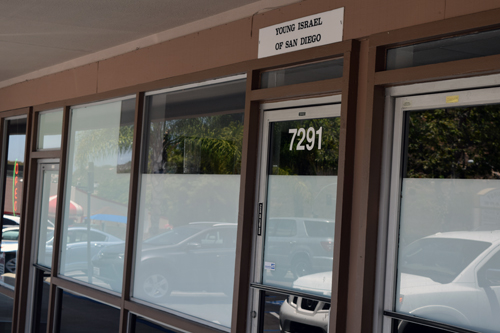
-24th in a Series-
Exit 9, Waring Road, San Diego ~ Young Israel of San Diego
By Donald H. Harrison
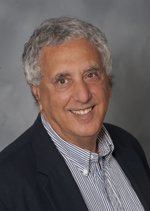
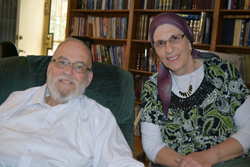
SAN DIEGO—“Rabbi” means “teacher” and Rabbi Chaim Hollander teaches Judaic Studies at Soille San Diego Hebrew Day School in the Kearny Mesa neighborhood and at Young Israel of San Diego in the San Carlos neighborhood, where he is the pulpit rabbi.
Born in post-war Germany to Holocaust survivors Leah and Karl Hollander, he was a year and a half old when the family immigrated to Youngstown, Ohio, where he attended secular schools and played pitcher, short stop and first base in Little League, Pony League, Babe Ruth League and for a semi-pro team called McCauley Awnings.
He grew up at the Conservative Temple Emanuel in Youngstown, a congregation that had several Orthodox teachers and an Orthodox cantor. Hollander’s mother came from a Chassidic background, kept a kosher home, and “was really determined that I should have a more religious life.” A possibility arose when he was 13 to study at a yeshiva in Skokie, Illinois, “but I wasn’t sure that was the direction I wanted to go in life” so Hollander declined the offer, preferring to stay at home.
Fate intervened when at age 15 ½ Hollander slipped and fell, breaking his instep. He couldn’t put any pressure on his foot, which meant he could not go to his school where one had to walk up three flights of stairs because there was no elevator. So for eight weeks, recalled Hollander, “they used to send me homework, but I didn’t need seven hours a day to finish homework. So I had a lot of time, and I was reading and I was thinking. I was growing up in the ‘60’s, a time of real idealism. I put my idealism toward religion rather than anti-war protests and all that stuff, although when I got to college I did protest against the conditions of Soviet Jews.”
Within a year of that religious exploration, Holocaust survivors Joseph and Edith Mann, who were Sabbath observant, moved into the neighborhood and took Hollander under their religious wings. They invited him to celebrate Shabbat with them, and under their influence, he became increasingly observant. Around this time also a Rothschild family moved to Youngstown, where Mr. Rothschild became the administrator of the Jewish Community Center. Rothschild was a graduate of Yeshiva University in New York City, and recommended that Hollander consider going there. Applying and winning acceptance, Hollander learned that YU offered three tracks of study. “One track was for those who had very little Jewish background, such as myself..” Another track was for students who were interested in doing their learning in Hebrew. The third track was a “strict yeshiva, a theological seminary, where every day they studied six hours of Talmud and so forth.”
Hollander enrolled in the first track “and I really enjoyed it. It began to click, and I decided that I would work hard to graduate from that program and get to the yeshiva part.” Reflecting on that period of his life, Hollander said he had realized that if he had decided when he was 13 to go to the Skokie yeshiva, he’d have been much further ahead in his studies, “and I wanted to make it up as much as I could, so I began to study more intensely to the point that not only did I study during regular classes but in the last couple of years, I had a good friend tutor us. We used to study three hours in the evening after our secular classes and after we finished our homework.”
“I worked very hard,” Hollander continued. “In fact, one summer I went to a Yeshiva University camp in the Poconos, where there was a Kollel in which a small group of fellows, perhaps 12 to 14 guys, sat together and learned all day. There was a three-hour break in the middle of the day. It was a wonderful opportunity. It really advanced my learning to the point that in my senior year when I was going to graduate from Yeshiva University, I decided that I wanted to continue to rabbinical school.”
About this time, Hollander was introduced at a mutual friend’s Shabbos dinner to Tema Reisman who, like Hollander, was active in protests in front of the Soviet Embassy to the United Nations over the treatment of “refuseniks” – Jews who were denied permission to emigrate to Israel or to the United States, and who were held in suspicion and sometimes thrown in jail for wanting to do so.
A woman who knew both families played the role of shadchan, asking Hollander if he would like to start dating Reisman with an eye toward marriage. He was willing, but first, he decided, there was something he wanted to make clear to her. After graduation from Yeshiva University, he planned to live at least a year in Jerusalem so he could study at the Chofetz Chaim Yeshiva. When he told that to Tema, known as “Temi” to her friends, she said she thought it was a wonderful idea. Soon they were married and on their way to Israel together. Three months later, Temi became pregnant with the first of eight children, six of them boys and two of them girls. Most of them are either rabbis or married to a rabbi.
By mid-2015, the Hollanders’ children had blessed them with 30 grandchildren. This is a matter of great sentimentality to Hollander, who explained “my father had five siblings. Of those six, only he and my uncle survived the war. My uncle never married, and my father was the only one who had children. We have to replenish the world!”
After returning to the United States from Jerusalem, Hollander began his teaching career. Too kind to mention names of schools where he was unhappy, he said it was sufficient to say that they were in the Northeast. At the first school, he spent a year teaching with no senior personnel observing his classroom until near the end of the year. When the principal told Hollander that if he came back the following year, he’d make a better teacher of him, Hollander responded that there had been a whole year to do that, but now he planned to move on. He “wasn’t thrilled” with the next school either, and this caused a career crisis. Maybe, thought Hollander, he was intended to do something else; maybe he should pick up a few more units in accounting.
At this point Tema intervened. Before he did anything else, she suggested, he should attend the annual memorial lecture for the father of Rabbi Hanoch Leibowitz, the Rosh Yeshiva of the Chofetz Chaim Yeshiva in New York City. Hollander wasn’t at all certain about the idea; it was a two-hour drive to New York City, and a two-hour drive back, and he had to teach the next day. “You can do it,” Tema told Hollander. “Just go.”
Following the lecture, Hollander stood in line to greet the Rosh Yeshiva, who bade him to sit down and tell him what had been going down in his life. “It impressed me that there were maybe 100 guys behind me and the Rosh Yeshiva treated me as if I was the only guy in the world, and everyone else could wait. I told him all my frustrations, and he said, ‘you know, if something comes up, I will give you a call.’ I felt good that someone had listened to me, but I didn’t think anything would come of it. But sure enough, it couldn’t have been more than five or six weeks later when I got a call from the Rosh Yeshiva. Actually his rebbetzin called me and when I came to the phone she said ‘I will pass the phone to the Rosh Yeshiva’ and Rosh Yeshiva said ‘there is something developing in New Orleans.”
To attract good quality teachers, a yeshiva in New Orleans had decided to create a mini-Kollel, at which adult students could learn intensively for half a day, and teach younger students the other half day. “A lot of fellows at that point had several children, so it was hard to continue learning but this was an opportunity to learn and still make money, and also their wives could get jobs teaching in the school as well.”
Accordingly, the Hollanders moved to New Orleans, where they greatly enjoyed the learning and the camaraderie with other mini-Kollel students and their wives. And during this time, Hollander received his smicha—he was now an ordained rabbi.
In July 1981, a former classmate from the Chofetz Chaim yeshiva, Rabbi Simcha Weiser, invited Hollander to join him in San Diego, where Weiser was becoming the headmaster at San Diego Hebrew Day School (which later was renamed Soille San Diego Hebrew Day School after Rabbi Henri Soille, a benefactor). Hesitating to leave the Kollel, Hollander needed a couple of days to think about the offer, but eventually accepted.
“I came here as a teacher with the idea that I would be in charge of the Judaic Department which I was for many years.” However, he grew restless with administrative duties and consulted with the Rosh Yeshiva who asked if he was well enough paid as a teacher. “Yes,” said Hollander, “thank God, Rabbi Weiser pays me very well.” So, asked the Rosh Yeshiva, “why do you want to be an administrator; what do you need the headache for? I realized the Rosh Yeshiva was right.”
***
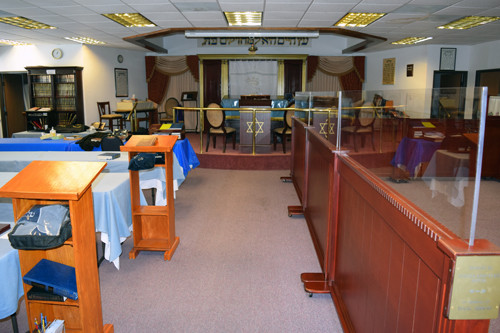
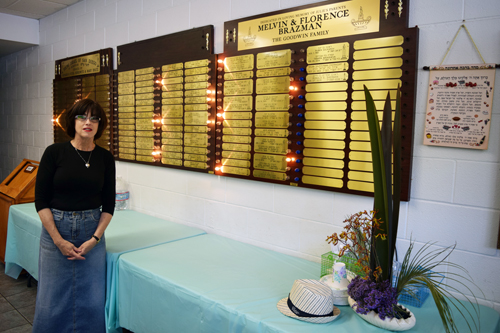
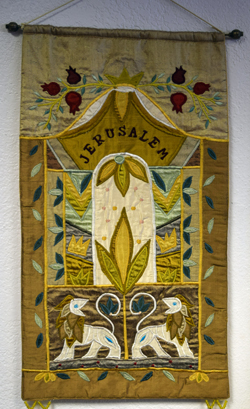
Meanwhile, Young Israel of San Diego had been created in 1989 in the San Carlos area, attracting a small group of Orthodox families. Like many start-up congregations, the membership of Young Israel initially met at each other’s homes, and eventually sufficiently to warrant renting a succession of small spaces.
Its founding Rabbi, Daniel Korobkin, served four years before moving on to Allentown, Pennsylvania, and then to Canada, where at this writing in 2015 he headed a very large congregation, Beth Avraham Yoseph of Toronto.
The second rabbi of Young Israel of San Diego, Rabbi Elchanon Snyder, was retained in 1993, the same year that Richard Goodwin was chosen to become the congregation’s president. Goodwin served from 1994 to 2003. Snyder departed in 1998 to take a position in New York City.
For a booklet that saluted Rich and Julie Goodwin while celebrating the congregation’s 20th anniversary in 2009, Rabbi Snyder wrote from New York about the origins of the Young Israel movement with which the congregation had affiliated.
The Young Israel movement began in the early years of the 20th century. The Orthodox shuls at the time were modeled on the European pattern, no singing and only married men leading the prayers and receiving aliyot. The youth began a movement to fight the religious apathy of the day. They wanted shuls that appealed to the youth, for the youth to run the prayers, to have singing and for the sermons and lectures to be in English. The Young Israel movement was the first movement to prove that orthodoxy was compatible with human life.
In the wake of Rabbi Snyder’s planned departure, Rabbi Hollander heard that a part-time position for a pulpit rabbi would be opening. After consulting with headmaster Rabbi Weiser at Soille San Diego Hebrew Day School, he applied for the position, certain that it would not interfere with his duties at the school. Morning prayers are held early in the morning at Young Israel, before school starts. And this, it turns out, is to the benefit of the school because one is not supposed to talk until one’s prayers are said. In that Rabbi Hollander already has completed his prayers by the time the students gather, he is free to offer commentary during the service.
In addition to its morning services, said Hollander, Young Israel of San Diego meets at nights and on the weekends, neither time conflicting with the school’s schedule. About the only time that Rabbi Hollander experiences a conflict is when he has to officiate at a congregant’s mid-week funeral, which, thankfully, has not occurred very often and about which Rabbi Weiser has always been compassionate.
Getting the Young Israel job required the Hollanders to move from their home in the College area, near Beth Jacob Congregation, where he davened, to a home in San Carlos, which is about seven-tenths of a mile from Young Israel. Normally this is not a demanding walk, but after the rabbi had knee replacement surgery in 2015, it was more than he could negotiate on foot. A non-Jewish colleague from Soille San Diego Hebrew Day School kindly agreed to push him in a wheelchair to Shabbos services until such time as he could complete the walk on his own volition.
Young Israel’s schedule of early morning services and evening services and classes, also makes the congregation a good neighbor for the several businesses that are fellow tenants in the small shopping center at the southwest corner of Navajo Road and Golfcrest Drive. In the morning, the only shop that is open is a donut shop—which probably would get a lot of business from shul-members if only it had kosher certification. Evenings, the only place open is a taco shop, which with carnitas (a pork product) featured on its menu, definitely is not kosher.
But a friendship has arisen, nevertheless, between the Mexican restaurant and the Orthodox synagogue, Hollander said. If there is a problem with the air conditioning, or other electrical equipment on Shabbos, when observant Jews may not turn electricity on or off, the non-Jewish personnel of the taco shop cheerfully come over and help fix it.
**
I asked Rabbi Hollander what, in his opinion, makes a good teacher, and although his answer applied to his role as an instructor with nearly 35 years tenure at the Hebrew School, it could be extrapolated to also pertain to his experience as a pulpit rabbi since 1999 at Young Israel. As I listened, I thought of the teachers he had told me about who had been important in his life, starting with the religious neighbors who influenced him as a teenager, and continuing even to the late Rosh Yeshiva.
“The most important thing – I really believe this—is to develop a one-to-one relationship with every single student,” Hollander told me. “I really try to do that. Every day at lunchtime, rather than staying in my room to eat lunch, or being in the teachers’ lounge, I go out there every day. I will sit down with the kids or they will sit down with me, and it is a time when everyone has a chance to just ‘let it down.’ It’s not a classroom, and so especially in the sixth, seventh and eighth grades, they really get to know me well. A lot of kids have had issues and they have felt comfortable enough to talk to me about them. I don’t know if I have helped them or not, but I have tried to. That is really important because that is an age when you are going through some tough physiological changes and it is hard to talk to your parents at that age because you are not quite sure what your relationship is with them. But I am not their parent.
“There have been a few kids who have felt that I have challenged them – I represented religion to them and they were rebelling against religion – but most kids are not like that,” Hollander continued. “Most kids view me as a person they can be comfortable to talk to. I think that I have kept the confidence of every child that I have spoken to, and I think that is important.”
The friendships he forms with his students, both boys and girls, have mutual benefits.
“In the classroom itself, I am there to teach; I have a curriculum and I have to cover the curriculum,” he stated. “Every school has to have some kind of discipline system, so we have one too,” he said. “If a child misbehaves, you give him a warning, then another warning, and then you send him down (to the principal) with a note. I have never had to do that. There have been times when I have told a child, ‘I’m sorry, you are going to have to sit outside the class for a couple of minutes and think about what you have done, and then I go and talk to them for about 30 seconds, and they realize whatever it was, and then they come back. When I talk to the kids I tell them ‘I really expect a lot more from you than that; I really have a great regard for you, and I have a great deal of respect for you, and you are disappointing me.”
He noted: “That was the attitude of the Rosh Yeshiva. I remember our yeshiva had a concept gdulat ha’adam, the greatness of man, and we as human beings have to live up to our greatness and that is how I view the kids too. I’m not saying I never have discipline problems; I am not perfect, but that is my attitude in teaching.”
His own children attended Soille Hebrew Day School, and he instructed all of them, in turn, except Pnina who attended classes for children with special needs. He told his other daughter and six sons that they were not allowed to call him “Tati,” which means ‘Daddy’ in Yiddish, but rather when in the classroom they should call him “Rabbi Hollander—that is what I am,” he related. “I suppose there were times that I was stricter with them than I was with the others because I didn’t want any of the students to feel ‘look he is favoring his own kids.’ I remember there were some other kids in the school who had their parents teaching and in the classroom they called the teacher ‘mommy’ or ‘daddy.’ How would another child feel? In fact, several of my children were so careful, that when they invited other children over to the house—for Shabbos or whatever—that in front of their friends they would always call me ‘Rabbi Hollander’ not ‘Tati.’ They got so used to it with their friends.”
I asked what lessons as an educator carried over to being a pulpit rabbi. “What is a rabbi, but a teacher?” he responded. “I teach the children; I teach adults, I teach teenagers. I think I have a certain ability that God gave me to be able to teach and I use it in the shul as well.”
Having taught for nearly 35 years at the day school, some of his students are now well into their 40’s with children of their own. “Several of my students have become members” of Young Israel of San Diego, Hollander noted.
“We have seen growth in the shul,” he said. “I am not just talking about numbers. Thank God, it has grown in numbers, it has perhaps tripled or quadrupled in size (to about 55 families). But you see the spiritual growth of people, which is what I am interested in. You see people growing as human beings and in their consideration and in their love of God and their love of Judaism – that is a very warm feeling.”
It has gotten to the point that Young Israel, which has occupied its space at 7291 Navajo Road since 2002 is not always able to accommodate the crowds at regular Shabbat services, let alone those held for the High Holy Days.
“We need to strike it rich and find somebody or some people who will give the wherewithal to buy a building, number one, and number two, decide where to put the building. You can’t move too far away because people have made commitments in buying homes within walking distance, so it has to be somewhere very near where we are now.”
Continued growth will occur, he said, especially if congregants buy into the concept of reaching out to people, and inviting visitors to their homes,” Hollander said. “When a person walks into the shul and someone comes over, saying ‘Here’s a siddur, here’s a chumash. Can I help you with something else’ then right away they are made to feel welcome.”
Knowing that first-timers to the Orthodox shul might be somewhat intimidated by a Torah service, the congregation is making an effort to introduce its members to the general public. Hollander would like people to know how interesting and accomplished some of Young Israel’s congregants are. Recently, the shul hosted a talk by a member who had served in the Israeli army, and other talks in the “get to know us” type series included a member who had been a first responder in New York City on 9-11, and a younger member who had participated in the March of the Living, which takes teens on visits to the Nazi concentration camps in Poland and continues on to visit the State of Israel.
Many Jews have a fear of Orthodoxy, Rabbi Hollander told me. “One of the biggest accusations against Orthodox is that we are closed-minded, and I just feel that people who are not Orthodox tend to be close-minded themselves. They are not willing to hear. I am not expecting them to become Orthodox, but at least they should hear it, and respect us for what we believe.”
The rabbi wound up our interview with a story, which was not a parable, but an actual occurrence, he said. A bearded man, wearing a black coat, while riding on a train, was hissed at by an assimilated Jew. “You know, it is really disgusting the way you look,” said the other man. “Why do you have to look like that? What’s the matter with you? Why don’t you look American?”
The bearded man looked up, and said, “I bet you think that I am a Jew. But I am not. I am Amish.”
“Oh,” said the man, now terribly embarrassed. “I am so sorry. It’s so wonderful that you practice your beliefs.”
The bearded man smiled, certain the man would understand the lesson. “Actually,” he said. “I am a Jew.”
From Waring Road Exit 9 proceed south to a left turn on Navajo Road. The synagogue is located in a small shopping center just before the corner of Golfcrest Drive.
*
Harrison is editor of San Diego Jewish World. You may comment to him at donald.harrison@sdjewishworld.com
Next: A synagogue for the arts
Harrison is editor of San Diego Jewish World. You may comment to him at donald.harrison@sdjewishworld.com, or post your comment on this website provided that the comment is civil and that you identify yourself by full name and by city and state of residence.